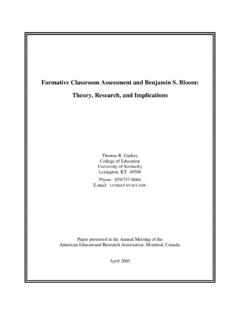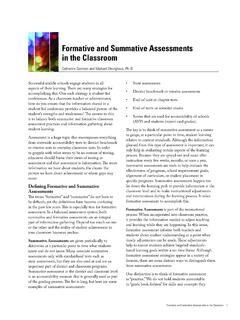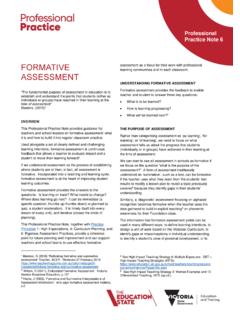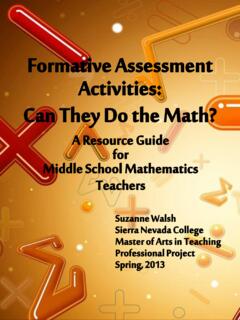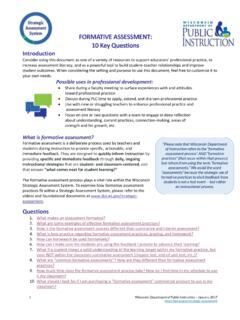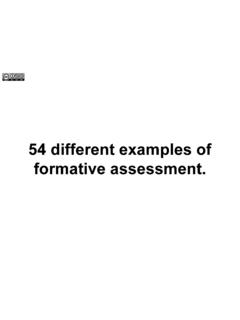Transcription of FORMATIVE ASSESSMENT - IMPLICATIONS FOR …
1 FORMATIVE ASSESSMENT - IMPLICATIONS FOR. classroom PRACTICE. Bet McCallum. Institute of Education ASSESSMENT is FORMATIVE only when comparison of actual and reference levels yields information which is then used to alter the gap. In FORMATIVE ASSESSMENT both the teacher and the pupil make judgements of the pupil's work and learning strategies against learning objectives. Both can give feedback about what is successful and the teacher takes the lead (as a more knowledgeable other) in deciding what is needed to close the gap. The pupil's responsibility is to use the information to close the gap. INTRODUCTION. This brief review takes six recent research studies on FORMATIVE ASSESSMENT and draws out their messages for classroom practice. While much of the work is based on good practice in primary teaching the messages are transferable to secondary teaching.
2 Black and Wiliam (1998) ASSESSMENT and classroom Learning [Black, P. and Wiliam, D. ASSESSMENT in Education Vol. 5, No 1 1998. Black and Wiliam's review of recent literature on FORMATIVE ASSESSMENT covers studies carried out in normal classrooms and in laboratory' settings. The main IMPLICATIONS of the review were summarised in Inside the black box (Kings College, London)]. ASSESSMENT Reform Group (1999) ASSESSMENT for Learning [ ASSESSMENT for L earning. Beyond the black box. University of Cambridge School of Education. 1999. This pamphlet is intended for policy makers and teachers and proposes that more emphasis be placed on using ASSESSMENT for learning, rather than of learning (summative).]. Torrance and Pryor (1998) Investigating FORMATIVE ASSESSMENT [Torrance, H. and Pryor, J. (1998) Investigating FORMATIVE ASSESSMENT .]
3 Teaching, Learning and ASSESSMENT in the classroom . Buckingham, Open University Press Primary Teaching Strategies, ASSESSMENT and Feedback funded by Economic and Social Research Council 1997 1999. ESRC Reference R000 23 7096. The authors report upon a qualitative research project which focuses closely on the teacher's strategies in authentic situations- the TAFS project - which looks at teaching, ASSESSMENT and feedback strategies used by Y2 and Y6. teachers considered to be `very good' by LEA inspectors]. Gipps, McCallum and Hargreaves (2000) What makes a good primary teacher? . expert strategies [Gipps, C., McCallum, B. and Hargreaves, E. What makes a good primary teacher? expert strategies' (forthcoming book to be published by Falmer Press, Sept 2000). This book is based on a research programme which looked at classroom teaching strategies.
4 ]. Clarke (1998 2000) teaching and feedback strategies Clarke, S. In-service Materials for teachers (1998-2000) Institute of Education, London 1. Getting it right: distance marking as accessible and effective feedback in the primary classroom . (forthcoming book chapter for Sept. 2000). Clarke writes about her intervention work with teachers on very specific teaching and feedback strategies Sutton writes for teachers on classroom ASSESSMENT . Sutton, R. (1995) ASSESSMENT for Learning. Salford, RS Publications LESSONS. The key lessons from the works studied are: FORMATIVE ASSESSMENT can have a strong impact on learning;. the role of pupils in ASSESSMENT is important;. where FORMATIVE ASSESSMENT is effective both teachers and pupils understand what they are doing. IMPLICATIONS FOR classroom PRACTICE.
5 Drawing on the studies forming the basis of this report, key components of FORMATIVE ASSESSMENT can be described as: Regular planned ASSESSMENT incidents';. Regular pupil self- ASSESSMENT ;. Feedback for learning;. Adjusting teaching to take account of the results of ASSESSMENT . 2. REGULAR PLANNED ASSESSMENT INCIDENTS. The studies emphasise that regular and planned ASSESSMENT incidents are part of FORMATIVE ASSESSMENT . Teachers are assessing all the time. There is no doubt that some ASSESSMENT goes on during teaching. Torrance and Pryor's teachers described assessing - while- teaching'. Their teachers picked up information about children's knowledge and learning strategies through eavesdropping and observing on the hoof' and they gauged the level' of general understanding of a class through quick fire quizzing at the beginnings and ends of lessons.
6 These techniques were used more to build or accomplish the lesson than to make useful assessments which could be fed back to children. This is evidence that, in general, teachers subordinate ASSESSMENT to instruction. The IMPLICATIONS are, that if FORMATIVE ASSESSMENT is to be effective, incidents need to be planned so that the goal of teaching is subordinated to the goal of determining children's level of achievement. There are IMPLICATIONS for pupil organisation and lesson structure. Given the complexity of classroom life and the usual size of classes, it is generally difficult for teachers to focus on the ASSESSMENT of individuals. The suggestion that ASSESSMENT incidents are focused on small group tasks seems reasonable: A focus group ASSESSMENT can generate a great deal of information about children's knowledge skills and understanding while at the same time contribute to the process of creating understanding.
7 Children can do a lot of talking when given time and space by a teacher prepared to listen and observe. Such talk provides evidence of children's progress to date but also scaffolds the learning of the group as they interrogate each other about the nature of the task and collaborate to accomplish it. (Torrance and Pryor, ). The National Literacy Strategy promotes a lesson structure that includes focus group work, hence this format is likely to be a feature of the natural environment of many ordinary classrooms and would not require deep change in organisational strategy. There are IMPLICATIONS for task design in ASSESSMENT incidents of this type. Tasks need to be carefully designed so that focused ASSESSMENT can take place. Open - style activities offering the opportunity for collaboration are more useful.
8 Sorting Leaves' task for 4-5 year olds is quoted by Torrance and Pryor. We have also seen many instances of appropriate activities including children's discussion/handling of historical artefacts and brainstorming the planning of fair tests or model making (TAFS). There are IMPLICATIONS for the teacher's role in ASSESSMENT incidents of this type An overt listener-observer/note-taker role is essential to learn about how and what pupils know, understand and can do. But the teacher also needs to use questions to provoke thinking. Observe, wait, listen, question' is a useful sequence to follow. The nature of teacher questioning has received much discussion in the studies used in this report. It is recognised that the IRF structure, which involves teacher initiation, pupil response and teacher's evaluative feedback, is widely employed by teachers and an embedded element of In ASSESSMENT incidents of the type suggested, it is likely that the teacher would need to make a deliberate attempt to avoid the evaluate' in IRF.
9 (Torrance and Pryor). Her questions would need to 3. seem genuine' ( not a test') prompting pupils into thinking about and thinking aloud their own learning strategies. Other pupils are then likely to appropriate these strategies. The teacher's responsibility would be to maintain a key role in structuring the dialogue, bearing in mind her own ASSESSMENT agenda and the kinds of knowing' she is looking for. (Torrance and Pryor). Active listening and focused observation are part of the good teacher's repertoire (TAFS) although skills may need to be developed in some other teachers. Questioning as an ASSESSMENT strategy has been discussed at school level in some schools (TAFS) but it is likely that much more work needs to be done. Really useful note-taking as part of observation will also require some examination and discussion.
10 There are IMPLICATIONS for the frequency of ASSESSMENT incidents of this type. Regular' is likely to be interpreted differently across schools. However, there is a view from research (Fuchs and Fuchs) that ASSESSMENT incidents need to be systematically planned and carried out between 2 to 5 times a week. Despite the recommendation (above) for dedicated focus group ASSESSMENT time, the most common lesson structure (and likely to prevail) is the three-stage format: - teacher introduction - pupil activities - plenary (TAFS). During the pupil activities stage teachers circulate, at times stopping and using a range of teaching, ASSESSMENT and feedback strategies with individual children (TAFS), with likely intentions and with various possible effects on the children (Torrance and Pryor). If teachers were made more conscious of these episodes, the IMPLICATIONS are that they could make even short interactions more formatively useful.











